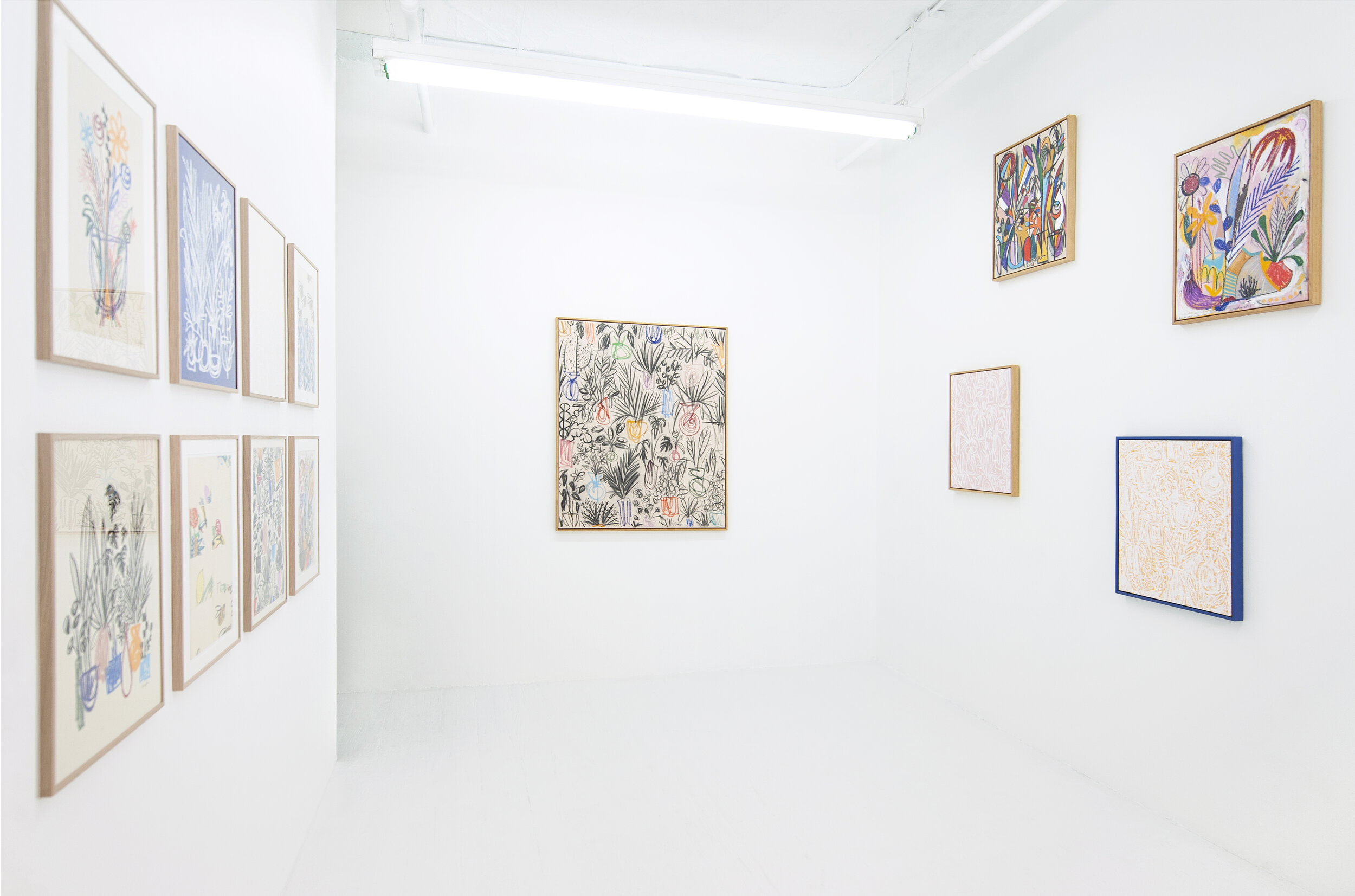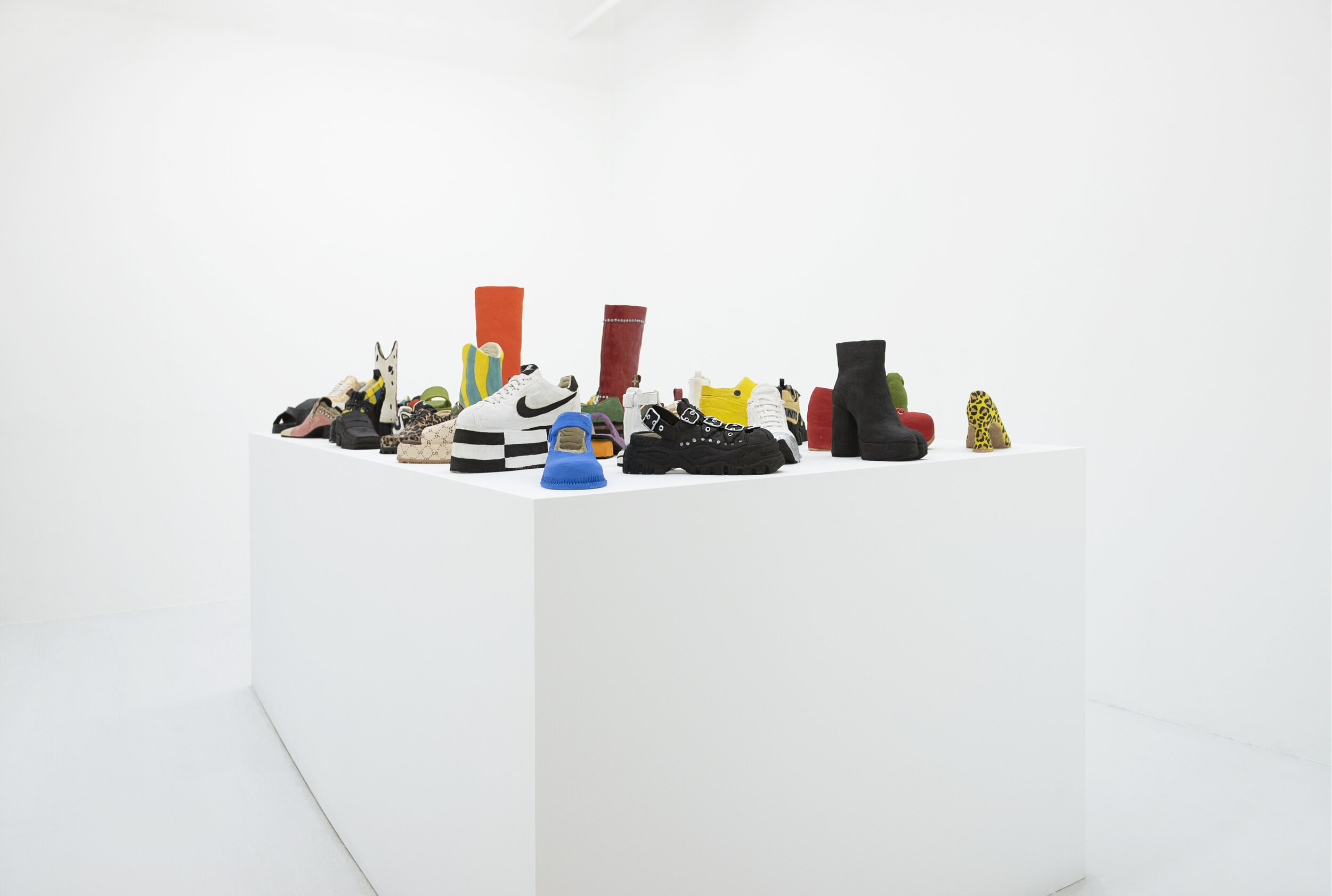Sam Trioli, Christin Graham & Tim Donovan of LAUNCH F18
LAUNCH F18
LAUNCH F18 was founded in 2011 by Tim Donovan and Sam Trioli. Since then, the program has conducted over 50 exhibitions, showing the work of emerging, mid career and established artists, including thoughtful exhibitions by gallery artists: Nathan Dilworth, Andrej Dubravsky, Eric Freeman, B.D. Graft, Meena Hasan, Erika Mahr, Frankie Rice, Didi Rojas and Bradford Willingham. In 2015, the moved to 94 Allen Street and in that time conducted eleven exhibitions, mounting shows with artists Eric Freeman, Matt Ducklo, Nathaniel Robinson, and curatorial projects by Jack Pierson, Dan Nadel and others. In 2016 the gallery returned to its Tribeca location where it continues to organize meaningful and ambitious exhibitions.
Interview with LAUNCH F18’s Sam Trioli
Questions by Sonja Teszler
Lovely to virtually meet you, Launch F18 Team – as a first question, what made you want to start a gallery?
It’s so lovely to meet you too! LAUNCH F18 really began out of the desire to simply “do something.” My business partner, Tim Donovan and myself were new to New York in 2009 and immediately fell in love with the process of organizing exhibitions, finding new artists and being a part of the art community here in the city.
How did Launch F18 gallery start and how would you describe its identity? What would you say is unique about your project?
LAUNCH F18 first formed out of independent curatorial projects we were doing throughout New England and New York City. When we found our permanent home here in New York we began to shift things to a more traditional gallery model, following what the programming and demands were naturally telling us. Ultimately though, we’ve always wanted the gallery to be adaptable, and evolve as needed. We’ve had so many unique and different chapters in our nine years that it seems as though it has really served us well, both as a business and most importantly creatively as well.
Installation view: Lauren Clay and Jaime Bull in Porthole Portico.
You have worked with a wide range of both local and international artists with diverse practices and backgrounds. How do you go about choosing your artists and is there anything specific you look for?
Discovering and learning about new artist’s is one of the many things we absolutely love about the gallery. Maintaining a diverse program is something that we’re really passionate about, especially since we enjoy making each exhibition a completely unique experience. Though we don’t always set out to look for something specific, we always love challenging ourselves with the work we show, and presenting something we feel is truly important for people to see and to experience.
How involved are you in the creative processes of your represented artists – do you give them a lot of space and freedom to come to you with a certain body of work or an idea, or do you take on more of a guiding role, giving them notes as they are making work for an exhibition?
We’re really firm believers in not getting in the way of our artist’s creative process. We’re here to offer support, and ideas when needed, but often times we allow for our them to really have an incredible amount of say and control in their work, exhibitions and installations. In the end, that trust and ongoing open dialogue is a truly important part of the relationship for us, and for them too.
Do you feel like you have a sense of community in your area or in New York city between smaller to midweight galleries and project spaces or does that kind of network have a more global dimension? Is community something you’re thinking about as a gallery (whether within the art scene or within your local context)?
Absolutely! Community is everything to us. One of the greatest parts of being located in the Tribeca neighborhood is that there is an incredible sense of community and diversity amongst programs here. Just within a few blocks you have gallery’s such as Canada and Bortolami along with Y2K Group and Page (NYC). There isn’t just one category of gallery that dominates the community here, which is really interesting and feels really fresh and vibrant.
My Hollywood Mirror, LAUNCH F18, New York. December 14 – January 18, 2020.
Could you talk about your current group exhibition, “Infinite Now”?
Infinite_Now stemmed out of the experience of organizing exhibitions, and seeing the influence of how social media can shape certain aspects of experiencing an artist’s work, or an exhibition. We’ve seen these almost alternative experiences form out of social media posts, almost infinitely connecting with people and evolving over and over again, even well after the exhibition might have closed. So, for the show we wanted to use those experiences as the foundation of it, and to be in dialogue with the fact that the exhibition exists across multiple platforms and spaces simultaneously, and almost infinitely.
At times, juggling the commercial and the creative element as an artist-‐run gallery can be tricky (at least from my personal experience)– how do you feel about this?
Certainly! In the end though we’ve always remained adaptable, and at times if the gallery demands more than we always step up to the plate. But, in working in this industry I think it’s important in general to take time to be creative no matter what. I think that it keeps us better connected to the actual making of art, as well as our own personal relationship to art.
What do you feel were some of the biggest challenges of COVID-‐19 on the art scene in general and on your space in particular? What was your response to the crisis in terms of your programming?
Our immediate response was to find unique ways to both support our artist, and provide a sense of reprieve from the overwhelming amount of difficult news. This has evolved in many ways since the beginning of March, but engaging with our community online, and in unique in person settings has been incredibly important to continue to work through.
I’ve been reflecting a lot on defining the progressive and sustainable use of a gallery during the lockdown period. Exhibitions, art fairs and degree shows have been going virtual, which arguably doesn’t equal the same kind of exposure their physical versions do. The “social ritual” that has always played a big role in shaping the curious island of the art world was taken out of the equation and galleries had to somewhat re-‐invent their function. I was wondering about your thoughts on this, meaning the importance of physical presence and the social scene for the art world, and on the question of the sustainability of current gallery and art fair models for both gallerists and artists?
This is such a great question. Years ago, we had a long conversation about this very topic, and boiled down this idea as much as we possibly could, ultimately drafting what our mission statement was. We arrived at the idea that we’re here to provide access to the arts to the larger public, and support artists and their voices. However our program may evolve, grow, or maybe even downscale, that idea always stays with us. As we found ourselves in our current situation, we just looked closely at what we were able to do appropriately and effectively, and build from there. We try to worry less about the things we can’t do, and just focus on what can, and doing that to the best of our ability.
Dog Days, LAUNCH F18, New York. January 23 - February 22, 2020.
Perhaps relating to the previous questions, what are some of the most important ways a gallery should support artists in the current situation in your opinion? I think there are so many ways! From online viewing rooms, to organizing unique interviews, conversations between artists and special features – I think that capturing and documenting everything that we’re experiencing and going through right now from an artistic and visual perspective is so important.
Could you talk about some of the current artists featured in your Online Viewing Room and how you approached curating this platform?
It’s funny because the online viewing room had been something that we’ve wanted to launch for quite some time, but for one reason or another it kept getting pushed back. The idea of the online platform though really spoke to us, and was a way that we could support more artists, and not be limited to what our exhibition schedule was. At the core of it, we see the viewing room as an archive in many ways, capturing unique perspectives on artists, their works, or even individual pieces. We feel so fortunate to have had the opportunity to work with artists such as Clifford Prince King, Rachael Tarravechia, Tommy Kha and many others. This fall we’re excited to collaborate with CHIAOZZA, Erika Mahr, Taylor O. Thomas and an incredibly unique performance piece by Chad Bentley.
Your program is quite diverse curatorially and you’re also hosting projects by external curators, explicitly focused on more experimental exhibitions that challenge the white cube format – “The Overlook” exhibition from 2019 looked particularly fun! Is this push for more innovative exhibitions something you consciously encourage and believe in?
Absolutely! We always want to challenge ourselves creatively and curatorially. How you experience an exhibition is something we’re thinking about constantly, from the space itself, to the marketing, image associations and creative content. We really view all of it as one, and truly love each and every aspect to it. For us, we always want to challenge and improve on the experience someone has when coming to see an exhibition – to consider these things just as a format is the death of a show for us.
It’s not very common for a commercial gallery to have an online shop, quite the opposite, galleries sometimes prefer to “tone down” the straightforward commercial element to their activities. Launch F18 on the other hand does have a shop that features unique items, prints and editions by your artists – could you talk about the ideas behind this initiative and your experience of how it’s worked out?
The thing that we love about our online shop is that it makes art even that more accessible for people. Not everyone can afford a painting that’s $1,000 never mind $50,000 or more. So, we see it as a great opportunity to connect with larger audiences, and people who love and appreciate these artists too. From a college student who might be buying their first print, to someone just starting out collecting, we truly enjoy the opportunity to open up the possibilities for all walks of life to engage with and enjoy art.
What are some positive and negative developments or trends you can see in the art world today, internationally and/or on the New York scene? What do you think there is more need for going into the future?
I think that the art world has such a remarkable capability to truly create positive change, and good in the world through visual language. It would be my mission to eventually bring art to those who truly need it, or don’t have access to it in the same way that we do in New York. I would hope that more cultural outreach could provide for positive impact in parts of the world that truly need the assistance and support.






